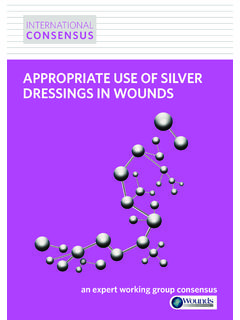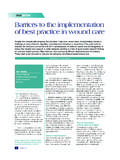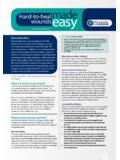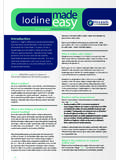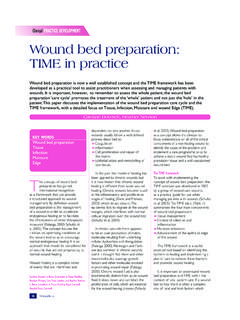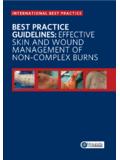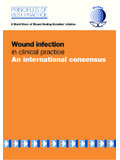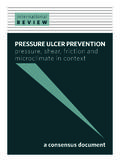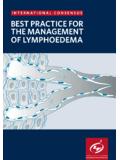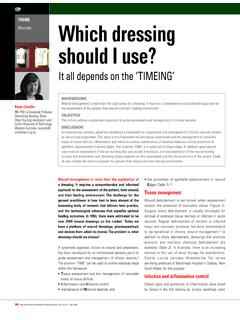Transcription of Triangle of Wound Assessment - Wounds International
1 IntroductionWound Assessment is essential in informing the selection of appropriate therapeutic strategies to achieve clinical goals, Wound healing and improved patient wellbeing. This Made Easy describes a new approach to Wound Assessment that encourages clinicians to look beyond the Wound edge to routinely assess and manage the periwound skin using the new Triangle of Wound Assessment . Authors: Dowsett C (UK), Protz K (Germany), Drouard M (France), Harding KG (UK). Full author details can be found on page of Wound assessmentWound Assessment can be defined as information obtained usingobservation, questioning, physical examination and clinical investigations in order to formulate a management plan1.
2 It can also provide a baseline from which to monitor the Wound , the effectiveness of therapeutic strategies over time and impact on patient concepts of Wound bed preparation and the TIME framework were devised to aid decision-making by linking Assessment findings to clinical actions2,3. Since then a number of Wound Assessment tools have been developed using the principles of Wound bed preparation4. Is a new approach to Wound Assessment needed?A global anthropological study was conducted in 2013 14 with the aim of better understanding the impact of a Wound on patients and to explore everyday Wound management practice5. A key finding from the study showed that practitioners separate Wounds into three distinct, yet interconnected, zones or axes: the Wound bed, the Wound edge and the periwound skin.
3 Although the Wound bed was judged to be the most intensely monitored zone, the study revealed that both healthcare practitioners and patients view management of the periwound skin as an integral part of Wound literature confirms that periwound skin problems are common. A survey of five English NHS Trusts (n=4772) found that 70% of patients had surrounding skin that could be characterised as dry, macerated, excoriated, or inflamed6 and a recent publication reported that, depending on exudate level, between 60% and 76% of Wounds (n=958) were surrounded by problematic or unhealthy periwound skin7. Given that unhealthy periwound skin is a significant problem in chronic Wounds , further exploration of Assessment of the periwound skin and its relevance to Wound progression needs to be considered within the Wound healing paradigm.
4 The periwound area has previously been defined as the area of skin extending up to 4cm beyond the Wound edge8; for some Wounds damage may extend outward, whereby any skin under the dressing may be at risk of breakdown and should be included in any Assessment . Frequent problems in the periwound area include maceration, excoriation, dry (fragile) skin, hyperkeratosis, callus and eczema. While current tools offer a standardised approach to Wound Assessment , they focus on the Wound itself and use limited descriptors to describe the periwound area4. There is a need for an easy-to-use Wound Assessment tool that fully integrates Assessment of the periwound area into the Wound healing paradigm5, Triangle of Wound AssessmentThe Triangle of Wound Assessment is a new tool that extends the current concepts of Wound bed preparation and TIME beyond the Wound edge5.
5 It divides Assessment of the Wound into three areas: the Wound bed, the Wound edge, and the periwound skin. It should be used in the context of a holistic Assessment that involves the patient, caregivers and family (Figure 1).madeeasy1 Wounds Asia | May 2015 of Wound AssessmentWound bedPeriwound skin Maceration Dehydration Undermining RolledWound edge Maceration Excoriation Dry skin Hyperkeratosis Callus Eczema Tissue type Exudate InfectionFigure 1 | Triangle of Wound Assessment . Adapted from5 Woundmadeeasy2 Using the Triangle of Wound Assessment The Triangle of Wound Assessment identifies three distinct, yet interconnected, zones or axes5, which call for different approaches:n Wound bed: look for signs of granulation tissue, while seeking to remove dead or devitalised tissue, manage exudate level and reduce the bioburden in the Wound .
6 N Wound edge: lower barriers to Wound healing by reducing undermining for dead space, debriding thickened or rolled edges, and improving exudate management to minimise risk of Periwound skin: rehydrate dry skin and avoid exposure to exudate/moisture to minimise the potential for 2 | Using the Triangle of Wound Assessment Wound bedExudateInfectionLevelTypeDry Low Medium High Local Pain or new onset Erythema Oedema Local warmth Exudate Delayed healing Bleeding/friable granulation tissue Malodour Pocketing Spreading/systemicAs for local, plus.
7 Erythema Pyrexia Abscess/pus Wound breakdown Cellulitis General malaise Raised WBC count Lymphangitis Please tickNecrotic __% Sloughy __% Granulating __%Epithelialising __%Thin/watery Thick Cloudy Purulent (yellow/ brown/green)Pink/red Baseline and serial measurements of the Wound size (length, width or area, and depth), appearance and location, will help to establish a baseline for treatment and monitor any response to interventions12,13. The method of measurement should be used consistently to aid meaningful tracking of changes over a specified number of days ( 7 14 days)14.
8 Problems identified in the Wound bed may extend beyond the Wound edge to the surrounding skin ( maceration, erythema, swelling). Please tick all that apply Please tick all that applyRecord tissue types and % of tissue visible in the Wound bedAim to remove non-viable tissue ( reduce infection risk)Protect and promote new tissue growthAim to treat cause ( compression therapy) and manage moisture balance (exception: dry gangrene)Aim to identify infectionManage bioburden to treat infection/control odourRecord level and type ( consistency and colour)Record signs and symptoms.
9 These may be aetiology-specificRecord Wound size: length __cm width __cm depth __cm Record Wound location Tissue typeFigures 2 4 show how the Triangle of Wound Assessment can beapplied to practice, with recommendations for documentation and treatment aims (Figure 5) to guide clinical decision-making. The Triangle of Wound Assessment should be used as part of a holistic patient a holistic Assessment A holistic Assessment aims to gain an overview of the patient s medical condition, the cause, duration and status of the Wound , together with any factors that may impede healing10,11 including:n comorbidities, diabetes, cardiovascular disease, respiratory disease, venous/arterial disease, malignancyTriangle of Wound Assessment3 Figure 3 | Using the Triangle of Wound Assessment Wound edgeDuring healing , epithelial cells migrate across the Wound bed to cover the surface of a Wound (epithelisation).
10 To allow migration, Wound edges need tobe moist, intact and attached to and flush with the base of the wound1. Assessment of the edge (or rim) of the Wound can provide information on Wound aetiology, how healing is progressing, and whether the current management plan is effective15. Common problems include: Please tick all that applyMacerationDehydrationUndermining Rolled edgesAssess edge of the Wound for moisture level Aim to establish cause and correctAddress patient concernsRefer to specialistAim to reduce the amount of undermining/allow the edge to reattach ( stimulate granulation)Aim to return the Wound edge to a condition that will permit epithethial advancementn medications, corticosteriods, anticoagulants, immunosuppressants, chemotherapeutic agents, non-steroidal anti-inflammatory drugsn systemic or local infection ( osteomyelitis)
